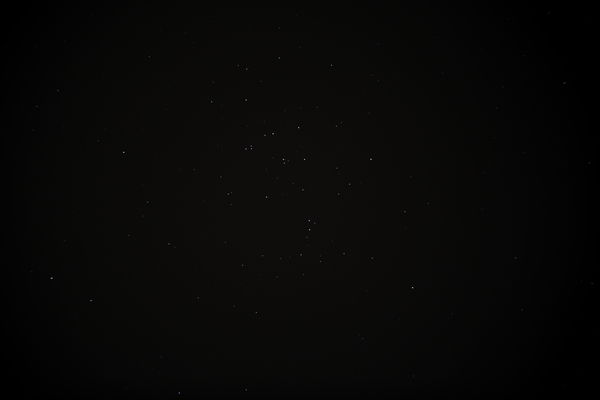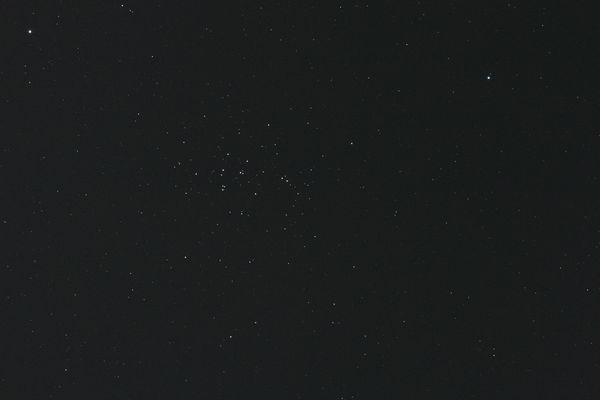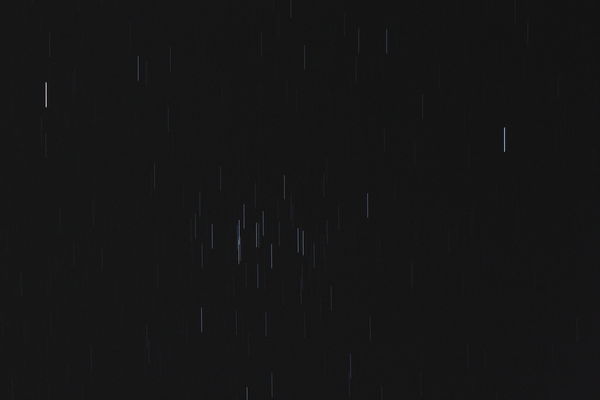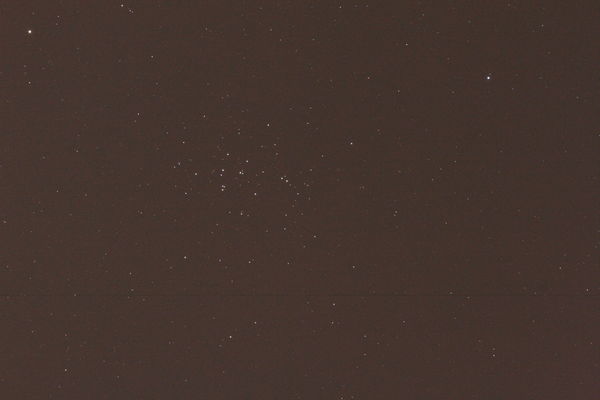Beehive
Apr 11, 2015 11:57:07 #
Canon 5D Mark II ISO 50 750mm f/5 45 seconds
Celestron AVX Newtonian
Skies cleared for a bit.
Celestron AVX Newtonian
Skies cleared for a bit.
Apr 11, 2015 15:04:31 #
Albuqshutterbug wrote:
Canon 5D Mark II ISO 50 750mm f/5 45 seconds
Celestron AVX Newtonian
Skies cleared for a bit.
Celestron AVX Newtonian
Skies cleared for a bit.
Nice and sharp in the center. I do see some coma distortion at the edges. There are a lot more stars in the Beehive and if you were to bump up the ISO quite a bit, the Beehive will really come alive.
Your equatorial mount is tracking perfectly for your 45 sec exposure.
If you are interested, I have a 2 sec shot with my 300mm f2.8 taken at ISO3200 with a full frame camera if you want to compare.
Just in case someone wants to know where the Beehive is located in the sky, stand looking south and then look up high to find Jupiter. Then look to the right perhaps 5 degrees or so. You would need to have a really dark sky to see it unaided. With my 7 x 35 binoculars, I can just start to see it. And with my 10 x 50 binoculars, it is about what you see in his image. And with a higher ISO, the number of stars goes way up.
Apr 11, 2015 18:02:39 #
I do not know why, but I have always been enthralled with the galactic clusters, both open and globular. With a spectrograph it amazing to see the miniscule amount of metals within the stars of these clusters. With such a low metal content it is judged that these clusters are some of the oldest structures in our galaxy, if not older than the main body of the galaxy itself.
Great Capture BTW
Matthew
Are you planning on amassing a collection of all the Messier objects?
Great Capture BTW
Matthew
Are you planning on amassing a collection of all the Messier objects?
Apr 11, 2015 18:27:51 #
JimH123 wrote:
Nice and sharp in the center. I do see some coma ... (show quote)
This is the scope that came with my AVX mount and I was trying to see how well it worked last night as far as focus.
I was shooting at low ISO to try and reduce light pollution since I live in a white/grey zone. I haven't aligned the mirrors or collimated the tube. It is as it came out of the box and the was to see what I needed to do with it.
I was pretty happy with the shot for the most part but know it needs work.
Just like Macro photography, we shoot, we post and we follow advice.
Thank you for the compliment and the advice.
It really is appreciated.
;)
Apr 11, 2015 18:31:18 #
Oknoder wrote:
I do not know why, but I have always been enthralled with the galactic clusters, both open and globular. With a spectrograph it amazing to see the miniscule amount of metals within the stars of these clusters. With such a low metal content it is judged that these clusters are some of the oldest structures in our galaxy, if not older than the main body of the galaxy itself.
Great Capture BTW
Matthew
Are you planning on amassing a collection of all the Messier objects?
Great Capture BTW
Matthew
Are you planning on amassing a collection of all the Messier objects?
Thanks for the compliment and I am just trying different things and testing equipment at this point.
What I really like are Nebulas and still working on expanding my list of Nebulas that I have captured.
Slow but sure.
:thumbup:
Apr 11, 2015 19:00:19 #
I do understand your love of the nebulae, especially imaging, visually only a few held my interest, since they are the pure definition of "faint fuzzy". I was so ecstatic when I first came out to ND because it was the first time I was able to see the Horsehead visually.
Speaking of macro I am so anxious for spring, but here that does not arrive till June. At least there is the great migration of water fowl to keep me entertained while I am supposedly working.
Matthew
Speaking of macro I am so anxious for spring, but here that does not arrive till June. At least there is the great migration of water fowl to keep me entertained while I am supposedly working.
Matthew
Apr 11, 2015 20:27:53 #
Albuqshutterbug wrote:
Thanks for the compliment and I am just trying different things and testing equipment at this point.
What I really like are Nebulas and still working on expanding my list of Nebulas that I have captured.
Slow but sure.
:thumbup:
What I really like are Nebulas and still working on expanding my list of Nebulas that I have captured.
Slow but sure.
:thumbup:
I have just started using star masks with photoshop. I am finding star only images easy to do. But when there are nebula or galaxies involved, it gets harder and harder and I haven't yet mastered it. I need to go back to some of my galaxy images and try to redo them using star masks. I wasn't pleased with what I was able to accomplish previously.
Apr 11, 2015 20:40:59 #
Oknoder wrote:
I do understand your love of the nebulae, especially imaging, visually only a few held my interest, since they are the pure definition of "faint fuzzy". I was so ecstatic when I first came out to ND because it was the first time I was able to see the Horsehead visually.
Speaking of macro I am so anxious for spring, but here that does not arrive till June. At least there is the great migration of water fowl to keep me entertained while I am supposedly working.
Matthew
Speaking of macro I am so anxious for spring, but here that does not arrive till June. At least there is the great migration of water fowl to keep me entertained while I am supposedly working.
Matthew
I do miss those dark skies! Living here south of San Jose, I don't have to wait long for spring. Its been here for several months already.
But the sky is not that dark. I can go up into the hills east of Morgan Hill where I live to Henry Coe State Park. The sky is dark there, but off to the north, the whole horizon is lit up by San Jose, some 25 mi away.
As a boy, growing up in Western Pennsylvania, and living way out in the country, I can recall some of those nights in which the sky was so dark that there were limitless stars that could be seen. I had a toy 3" reflector with two eye pieces, one for 40x and one for 80x. The 80x eyepiece was useless, but I can remember the view through the lower power eyepiece. And with those dark skies, it was something to remember. But the problem was that clear nights were few and very far between. Cloudy (and rainy) seemed to be the normal state. Now, sunny is the normal, but there is the light pollution problem. Have done some experimenting with astrophotography using an IR modified camera, and the light pollution does not extend so much into that region of the spectrum. Lick Observatory, which I can see the telescope domes from my driveway, does all their work now in near IR.
Apr 11, 2015 20:46:06 #
Just from my own personal experience with trial and error, I would use one mask for the stars, two or even three for the hi, mids and lows of the nebula and one or two to bring out the background. Just a word of advice, I have not been working on astro imaging long, but have over a decade in the use of photoshop, only adjust levels/curves on a duplicate layer otherwise it is so easy to get caught up in PP that you actually do more harm than good. I tend to work on an image for no more than an hour before saving and going on to something else or at least taking a break. Fresh eyes are always your best friend.
Matthew
Matthew
Apr 13, 2015 14:06:02 #
Albuqshutterbug wrote:
Canon 5D Mark II ISO 50 750mm f/5 45 seconds
Celestron AVX Newtonian
Skies cleared for a bit.
Celestron AVX Newtonian
Skies cleared for a bit.
Very nice pinpoint stars Jim.
45 sec means you really getting there.
Craig
Apr 13, 2015 16:09:21 #
CraigFair wrote:
Very nice pinpoint stars Jim.
45 sec means you really getting there.
Craig
45 sec means you really getting there.
Craig
Now if I can just get you to quit sending me your clouds.
I don't mind if they have rain but yours are just PITA's.. lol
How are you coming with yours?
Apr 13, 2015 17:11:15 #
Albuqshutterbug wrote:
Now if I can just get you to quit sending me your clouds.
I don't mind if they have rain but yours are just PITA's.. lol
How are you coming with yours?
I don't mind if they have rain but yours are just PITA's.. lol
How are you coming with yours?
I had help at the star party.
Sat night I got a 28.35" sec error in polar alignment which is almost the same as the Polaris offset from Celestial North.
I used 2 Alignment stars and 4 calibration stars. And then did a Polar Align.
Today I got my Celestron Polar Finder Scope in the mail and can't wait for it to get dark.
I have to hurry at sundown because the fog roles in at about 9:00 Pm.
Give me back the partial clouds any time.
Craig
Apr 13, 2015 23:55:06 #
CraigFair wrote:
I had help at the star party.
Sat night I got a 28.35" sec error in polar alignment which is almost the same as the Polaris offset from Celestial North.
I used 2 Alignment stars and 4 calibration stars. And then did a Polar Align.
Today I got my Celestron Polar Finder Scope in the mail and can't wait for it to get dark.
I have to hurry at sundown because the fog roles in at about 9:00 Pm.
Give me back the partial clouds any time.
Craig
Sat night I got a 28.35" sec error in polar alignment which is almost the same as the Polaris offset from Celestial North.
I used 2 Alignment stars and 4 calibration stars. And then did a Polar Align.
Today I got my Celestron Polar Finder Scope in the mail and can't wait for it to get dark.
I have to hurry at sundown because the fog roles in at about 9:00 Pm.
Give me back the partial clouds any time.
Craig
I had to wait till 9 my time for the clouds to give me a break.
Shooting 1 minute shots of the hive at 1600 f/11 at the moment. I'll have to color correct but the results look promising. Of course it may look like garbage on the big screen.
Apr 14, 2015 01:05:35 #
Albuqshutterbug wrote:
I had to wait till 9 my time for the clouds to give me a break.
Shooting 1 minute shots of the hive at 1600 f/11 at the moment. I'll have to color correct but the results look promising. Of course it may look like garbage on the big screen.
Shooting 1 minute shots of the hive at 1600 f/11 at the moment. I'll have to color correct but the results look promising. Of course it may look like garbage on the big screen.
Or the same as before to me.
Canon 7D 300mmL f/11 ISO 1600 60 second exposure
Second shot is 45 second untracked.
Craig I did a planetary alignment using Jupiter to save time.
It worked nice.
Apr 14, 2015 10:48:20 #
Albuqshutterbug wrote:
Or the same as before to me.
Canon 7D 300mmL f/11 ISO 1600 60 second exposure
Second shot is 45 second untracked.
Craig I did a planetary alignment using Jupiter to save time.
It worked nice.
Canon 7D 300mmL f/11 ISO 1600 60 second exposure
Second shot is 45 second untracked.
Craig I did a planetary alignment using Jupiter to save time.
It worked nice.
Very interesting series. What did you do to get rid of so much noise without loosing pinpoint stars??? The Black Slider.
Craig
If you want to reply, then register here. Registration is free and your account is created instantly, so you can post right away.







